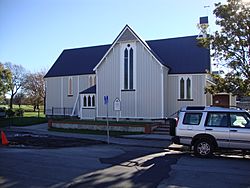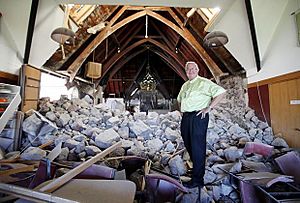St Saviour's Chapel facts for kids
Quick facts for kids St Saviour's Chapel |
|
|---|---|
| St Saviour's at Holy Trinity | |

St Saviour's Chapel at its Cathedral Grammar School site
|
|
| 43°36′07″S 172°43′18″E / 43.601833°S 172.721559°E | |
| Location | Lyttelton |
| Country | New Zealand |
| Denomination | Anglican |
| Website | http://lytteltonanglican.wixsite.com/ |
| History | |
| Consecrated | 29 October 1885 |
| Architecture | |
| Heritage designation | Category II |
| Designated | 24 June 2005 |
| Architect(s) | Cyril Mountfort |
| Administration | |
| Diocese | Christchurch |
St Saviour's at Holy Trinity is a special Anglican church located in Lyttelton, Christchurch, New Zealand. It has a fascinating history of moving around! This church, originally called St Saviour's Chapel, was first built in West Lyttelton. In the 1970s, it was moved to Christchurch to be part of the Cathedral Grammar School. After some big earthquakes damaged the original Holy Trinity Church in Lyttelton, St Saviour's Chapel was brought back home in 2013 to take its place.
Contents
The Church's Early Days
The first vicar (church leader) in Lyttelton was Benjamin Woolley Dudley. He arrived in New Zealand in 1850. In 1883, Mr. Dudley suggested that the Lyttelton church area should be split. He wanted a new church built for people living in West Lyttelton and for sailors visiting the port.
Mr. Dudley even gave money to help build the new church and pay for a minister. The area of West Lyttelton got its own church section, and a new minister was appointed in 1885.
Building St Saviour's Chapel
Cyril Mountfort was chosen to design the new chapel. He designed it in a style called Early English Gothic Revival. This means it looked like old English churches, with a steep roof and tall, narrow windows. The chapel was built using timber (wood).
During construction, parts of the building were brought to the site. This was at the corner of Simeon Quay and Brittan Terrace in West Lyttelton. The pieces were then bolted together. St Saviour's Chapel was officially opened on 29 October 1885 by Bishop Harper. The design allowed for more sections to be added later, but the church never grew big enough for that to happen.
Famous Visitors
A very famous explorer, Robert Falcon Scott, visited this church. He and his crew worshipped here before their trips to the South Pole. These trips were called the Discovery and Terra Nova expeditions. Scott and his team reached the South Pole on the Terra Nova trip, but sadly, they did not survive the journey back.
Moving the Church
In 1964, all the churches in Lyttelton became one big church area. Over time, St Saviour's Chapel became less important than Holy Trinity Church on Winchester Street. In 1975, the people who looked after St Saviour's offered the building to the Christchurch Diocese.
The church leaders decided to give the chapel to Cathedral Grammar School. So, the chapel was carefully taken apart into its sections. In 1976, it was moved by truck to the school grounds in Christchurch Central City. The original altar (the table used in church services) from St Saviour's was given to a science department. It is now in the Chapel of the Snows at McMurdo Station in Antarctica.
Returning to Lyttelton
In February 2011, a big earthquake hit Christchurch. St Saviour's Chapel itself was only slightly damaged. However, the ground it was on at Cathedral Grammar School was damaged. This meant the chapel had to be moved so the ground could be fixed.
The headmaster of Cathedral Grammar School, Paul Kennedy, offered the chapel back to the Christchurch Diocese. Bishop Victoria Matthews decided that St Saviour's Chapel should go back to Lyttelton. It would replace Holy Trinity Church, which had been torn down after the earthquakes. In July 2013, the Christchurch City Council gave a grant of NZ$143,000 to help with the moving costs.
The foundation for the church's new home was laid on 18 August 2013. In September 2013, the St Saviour's building was cut into ten pieces. It was then moved through Gebbies Pass to its new location in Lyttelton. The church was renamed St Saviour's at Holy Trinity. Bishop Matthews officially opened it on 7 June 2015.
People have worshipped on this site since 1850. St Saviour's is the third church building to stand there. The main part of the church is still St Saviour's Chapel. However, it has been turned around. What was once the sanctuary (the main holy area) is now the nave (the main seating area) at the west end.
Saved Features
Some parts of the old Holy Trinity Church were saved and added to St Saviour's. This includes the porch. The altar and other features were also reused. A special stained glass window designed by William Butterfield was saved from the old church. It is now in the sanctuary of the new church. The organ from the 1865 Holy Trinity Church has also been repaired and is now used in St Saviour's.
Heritage Status
The church is recognized as an important historical building. The New Zealand Historic Places Trust (now Heritage New Zealand Pouhere Taonga) officially listed it as a Category II heritage building on 24 June 2005. This means it has historical or cultural importance. On 1 May 2017, its status was upgraded to Category I, meaning it has even greater historical significance.


